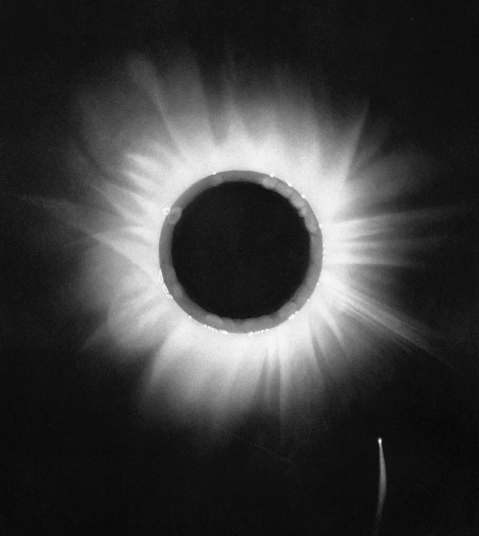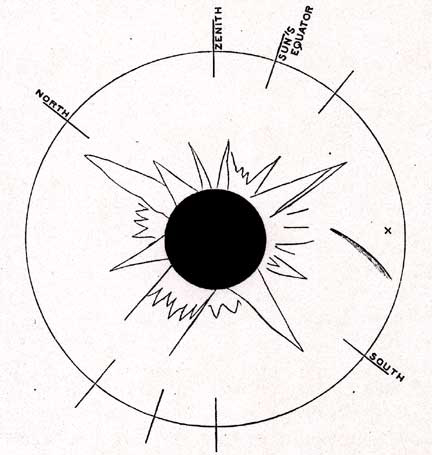
Perihelion: 1882 May 17.5, q < 0.01 AU
On May 17, 1882, the path of a total solar eclipse crossed northern Africa, the Middle East, and southern Asia. As total eclipses go, it was a relatively short one, with the maximum duration of totality – which occurred in present-day Turkmenistan – being only 1 minute 50 seconds.
Many scientists of the time viewed the eclipse from Egypt, where the duration of totality was even shorter – barely over 70 seconds. During totality, many of those who were there saw, and photographed, a bright “luminous streak” a little over half a degree from the limb of the sun, which was soon realized to be the tail of a bright comet. The comet was obviously quite bright, at least magnitude 0 or brighter, and the tail, which was aimed in a direction roughly tangential to the sun-comet line, was estimated to be 20 to 30 arcminutes long. Despite the short duration of totality it appeared to exhibit a slight motion during the interval of time that photographs were taken.
Once totality was over the comet was never seen again. By general agreement of those who had visited Egypt to observe the eclipse, the comet was given the name “Tewfik” after Mohamed Tewfik Pasha, the then-Khedive of Egypt.

It is obviously not possible to determine an unambiguous orbit for Comet Tewfik from the very limited positional information that is available. However, its location with respect to the sun, the motion it appeared to exhibit during totality, and its overall appearance are all consistent with its being a Kreutz sungrazer, and it is widely considered as being a member of that group of comets. Perhaps adding some weight to this conclusion is that bright Kreutz sungrazers appear to come in “clusters,” and such a “cluster” arrived during the early 1880s. A bright sungrazer appeared in February 1880, and just a few months after Comet Tewfik came the Great Comet of 1882, one of the brightest comets in all of recorded history and a future “Comet of the Week.” Yet another, and somewhat dimmer, Kreutz sungrazer appeared in January 1887. Kreutz sungrazers, including this phenomenon of apparent “clustering,” constitute the subject of a future “Special Topics” presentation.
Due to the nature of these two phenomena, the observation of comets during a total solar eclipse is a very rare occurrence. It has only been accomplished a handful of times, and indeed, Comet Tewfik is the first confirmed example (although there are a couple of uncertain earlier reports). This rather unique aspect of observing comets is the subject of this week’s “Special Topics” presentation.
More from Week 21:
This Week in History Special Topic Free PDF Download Glossary
Ice and Stone 2020 Home Page


